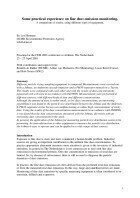Air Monitoring
Some practical experience on fine dust emission monitoring. A comparison of results, using different types of equipment.
Oct 06 2014
Author: Leo Hermans on behalf of CEM
Summary
Different particle sizing sampling equipment is compared. Measurements were carried out with a Johnas, an Andersen cascade impactor and a PM10 separator monted on a Tecora. The results were compared with each other and with the results of dust concentrations measured with a Tecora in accordance with ISO 9096. Measurements were performed at different sources; with different kinds of dust and different concentrations.
Although the amount of data is rather small, at low dust concentrations, an interesting resemblance was found in the particle size distribution between the Johnas and the Andersen. A PM10 separator at the Tecora was malfunctioning at rather high concentrations of sticky dust. Using the results of the dust concentration measurements in accordance with ISO9096, it was found that the dust concentration, measured with the Johnas, decreases with an increasing dust concentration in the stack.
In general, the application of the Johnas for measuring particle size distribution seems to be promising. In contradistinction to other equipment to measure the particle size distribution, the Johnas is easy to operate and can be applied in a wide range of dust sources.
Introduction
Exposure to fine dust is more and more considered a human health problem. Industrial sources are giving an important contribution to the ambient fine dust concentrations. To practice appropriate abatement measures more attention is given to the inventory of industrial emissions. In general in The Netherlands it is not common use to deal with fine dust emissions in environmental permits. Only the concentration or emissions of total dust are limited. So, by absence of enforcement, there is still no need to diagnose the particle diameters of dust emissions.
In practice, the fine dust emissions are often derived from the permitted total dust emissions or from the measured total dust emissions. In this way, large and undefined errors are made. Monitoring of fine dust emissions by specific measuring equipment is often considered to be uncertain, difficult and expensive.
To abolish this prejudice, DCMR Environmental Protection Agency started comparison measurements with specific fine dust emission measuring equipment. The work was done in close collaboration with measuring teams of Corus, Pro Monitoring and KW2. Measurements were carried out with different fine dust separating probes. To monitor the effect on the results due to the properties of dust, the concentration and different source parameters, the measurements were performed at different stacks.
Digital Edition
IET 34.2 March 2024
March 2024
Gas Detection - Biogas batch fermentation system for laboratory use with automatic gas analysis in real time Water/Wastewater - Upcycling sensors for sustainable nature management - Prist...
View all digital editions
Events
Apr 18 2024 Shanghai, China
Apr 22 2024 Hannover, Germany
Apr 22 2024 Marrakech, Morroco
Apr 23 2024 Kuala Lumpur, Malaysia
Apr 23 2024 Kintex, South Korea















